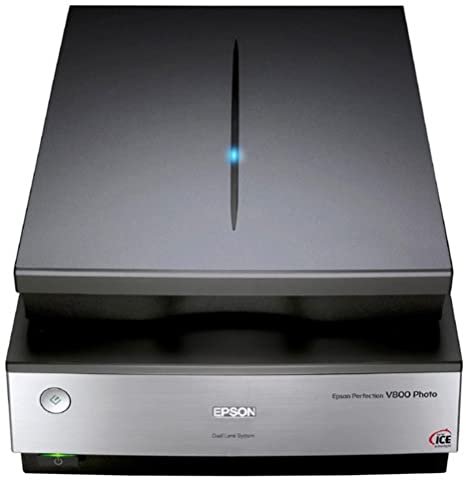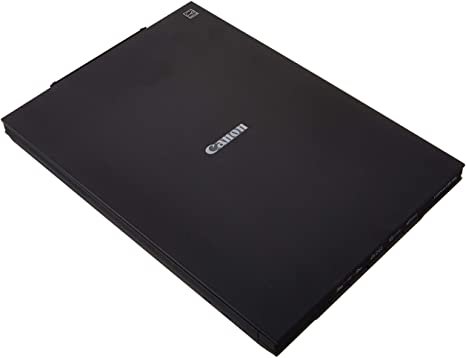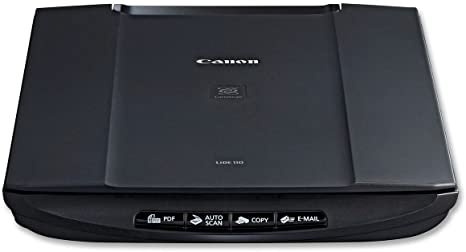Epson Perfection V800 Photo scanner
Top Reviews:
I purchased this scanner to handle a significant volume of medium and large format vintage negatives, roughly one quarter of them glass. It is well designed and produces exceptional scans. It is also more sophisticated than my prior scanners and I am still becoming acquainted with its features after 75-80 scans.
Very little about this scanner is perfect. I read the reviews before buying it but soon discovered a number of very annoying shortcomings. I use the scanner to scan batches of twelve slides. First, if you are using this with a Macintosh computer, regardless of the programme or the model, you will have to constantly activate the scanner by maintaining the app at the forefront and clicking it after every scan. There is no such thing as walking away for a coffee or even working on the computer with a different app as the scanner works away in the background: the scanner simply falls asleep after every second slide. This has been noted by many other reviewers, well over a year ago, but even with the latest update it remains a problem. Second, the scanner accurately "sees" the slides in preview, but when it proceeds to scan them it gets about one in ten wrong, meaning it mistakes a vertical slide for a horizontal one. These will have to be rescanned. Third, do not buy this for the colour restoration programme, it is very disappointing. Maybe, if you are an expert, you can fiddle around with it and adjust it, but otherwise it is a definite no no. Fourth, the on and off button at the bottom is incredibly flimsy, it can be hard to switch the thing on. The good news is that if you manage to gather the patience to sit next to the scanner and keep it going, the results are reasonably good. The dust removal is very effective and probably the best feature of this scanner. That's about it.
I’ve had the Perfection V800 Photo scanner for about six weeks now, and have held off writing this review until I had time to gain experience with it.I do a lot of scanning for local artists, making digital record copies of paintings, and the main reason I bought the V800 was to replace an earlier Epson scanner for this task. Bottom line, I am very pleased with the scanner’s performance for this, with reflective flat art and photos. Resolution, color depth, and color accuracy are superb.I cannot, however, report the same level of happiness with transparent art and photos – although reviews of this machine heralded slide and negative scanning as its crowning feature. I do a lot of scanning of both 35mm slides and negatives for archival purposes, using a Nikon Super Coolscan 4000 dedicated film scanner, and I was really hoping that the Perfection v800, being able to scan 12 slides at a time, or 18 negatives at a time (using the supplied plastic film holders), would increase productivity versus the virtually one-at-time workflow of the Nikon.And indeed, I can scan more frames quicker with the V800 than with the Nikon – but the quality is not the same. Problem is that when slides get old, film starts to bow, physically varying the focal point for the scanner. And some of them bow more than others. So you put 12 slides in the film holder and then adjust the manual sliders the best you can (a cumbersome process versus auto-focusing with the Nikon). Results for slides do not meet the critical standards I require, after running more than a hundred slides through both processes and comparing results side-by-side.Results in scanning 35mm color negatives are much better, and this seems to be due to the fact that the film holders for negatives have glass on one side and a snap-down cover on the other, holding the negatives down much flatter. You still have to adjust the sliders on the film holders manually to achieve good focus, versus the auto-focus with the Nikon – but the resulting quality from the V800 with 35mm negatives is much better than with 35mm slides. In fact, at 6400dpi, results for negatives are almost as good as from the Nikon scanner at 4000dpi. For most users, I think they’d be just fine, but I’ll stick with the Nikon anyway for my work.Just for the record, I’m using a Mac and doing post-scan processing in Adobe Photoshop, Adobe Camera Raw, and Adobe Lightroom. Scan software is Hamrick VueScan professional, which will scan to a dng file for post processing. The included EPSON Scan software is quite good, by the way, and reasonably user-friendly even in its Professional Mode – but will only go to a regular tiff file and not dng.
Canon CanoScan Lide 400 Slim Scanner, 7.7" x 14.5" x 0.4"
Top Reviews:
This scanner works really well for artwork and is extremely easy to set up. I just popped in the disc it came with and followed the instructions and then plugged it in when the instructions prompted me to do so. I also found a youtube video that reviewed this scanner which helped my decision. The guy (Teoh Yi Chie) shows everything you need to know about the program as well. Also, the scanner door does not need to be closed while scanning. Perfect for sketchbooks. I usually put a small weight (such as a heavy book or paperweight) on top of my sketchbook to keep the paper in contact with the glass while scanning.
This says that it's mac compatible but it is not right out of the box. At least, not without a lot of extra work and money. The model I got was the CanoScan LiDE 400.First of all, the cable is USB C. However, it's only USB C on one end, and that's the end that goes into the scanner, not into the computer. The other end is standard USB. So, if you have a Mac laptop that hasn't had the old style USB port in years, you'll need an adaptor.Second, I chatted with both Amazon and Canon tech support because the Canon IJ Scan Utility Lite would not find or recognize the scanner, no matter what I tried. And yes, the first thing I did was switch the bottom travel lock switch to "unlocked". The software would not find the scanner, despite the fact that the scanner powered up every time the cord was plugged in. The computer knew it was there, the scanner software would not. I could not even add the scanner as an option in Mac's printer system preferences because it just would not show up.Finally, I researched alternative software downloads that could be used instead of the basic Canon one. I found VueScan for Mac. I downloaded it, and it connected to the scanner immediately. It did a gorgeous test scan at 1200dpi, but saved it with a watermark until I buy the 44.99 VueScan software license.So the scanner is an excellent slim, light and portable size and does really nice quality scans for the price. However, now I'm out $19.00 for an adaptor and another $44.99 just so I can use the thing. So much for a good deal.You need to seriously reconsider calling this "mac compatible", Canon.
I just tried this LiDE 400 scanner on my laptop running Windows 7 64 bit using the downloaded Canon software. Everything I tried works fine so far. Based on another review I scanned a page with punch holes and the scann came out flawless. I scanned photos at 600dpi and worked fine (that's the maximum of the scanning software). I don't know how to get those 4800dpi Canon Claims to have. The cable is standard USB to USB-c. I tried the scanner with a different cable than the one provided (a cell phone cable) and it works just the same, so it is not a propietary cable.So far everything works.
Canon LiDE110 Color Image Scanner (Discontinued by Manufacturer)
Top Reviews:
I need to scan about 15-20 thousand printed photos, to move into the modern age and share with family members easier. I didn't want to shell out lots of money for something I could do myself(35mm I wouldn't do, don;t trust myself lol).I can scan 3 4x6 pictures, at once, in 40 seconds flat(same time recorded for 2 at once).... at 600dpi. Doing one 4x6 picture takes 32 seconds flat. Of course, I am not counting the seconds it takes me to lift the lid and put them in.Good thing I have A LOT of free time(being a 20 year old with back surgeries and such during the summer, not many activities for me and I live AT a beach lol).I also bought cotton gloves to keep my finger grease off the photos, makes me feel like I'm a "pro" xD.Altogether this should take me 75-80 hours of work to just SCAN them(for 60 bucks that's a good deal, though!). I still want to have them "retouched" to get minor blemishes that older kodak pictures naturally produced.If you have any suggestions for good software that has a nice auto feature, please let me know!
This was my first scanner purchase in over 10 years. Scanners have come a long way and I was surprised by how much you get for so little money with this unit. You can get the technical specs from Amazon or the Canon website. It ships in a small box with one USB cable and start guide/CD ROM software. Instead of loading programs from the CD and having to do updates I just went right to the Canon website and looked up the latest software and drivers to make this work with my machines. I was up and running in under 5 minutes. The software is easy to use and you just drop and drag files of the newly scanned things to your drives on your machines. It works great with both windows and iOS. I also really like that no external power supply is needed. The USB cable handles and data and power in one. So far I have scanned a few paper documents and a few diagrams from books. They look fantastic and resolution can be adjusted to get really good results. For home use it is a really great value. My last scanner/printer/copier/fax in one machine was $350 in 1999. This was a pleasant surprise. BTW, if you need it just for one project then it is very easy to resell this item. I have seen used ones go on the online auction sites for $30-35. Not a bad deal at all to "rent" a new one for about $20 if you will never use it again and it will end up junked a few years from now. Oh, and it is made in Vietnam and not China; a huge plus not supporting communism.
This scanner came in a crushed box, no safety package marking.....the scanner lid is warped, the seal foam crushed...so i had to fix /jury rig that....... with a weight placed on top it does work.


